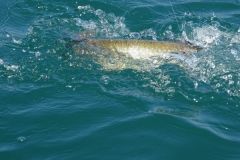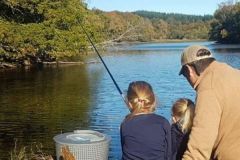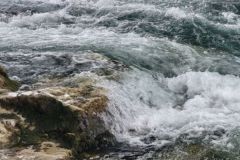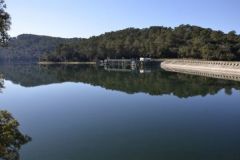What are the differences between harmful and invasive species?
Invasive species can cause problems for certain aquatic ecosystems, but they are not yet classified as harmful, which means that they are likely to cause biological imbalances in the water.
In both cases, special regulations have been introduced.
It is forbidden to transport them alive, sell them, introduce them into another environment, release them after capture, or use them live or dead for fishing.
Other species, such as certain crayfish, are also classified as species likely to cause biological imbalances.
Harmful species
To date, only two fish have been classified as harmful: catfish and sun perch, as well as certain crayfish.
Native to North America, the catfish belongs to the Siluriformes group, just like the sheatfish, which is the largest freshwater fish in the world, and a non-nuisible one at that, I must insist, despite the displeasure of some "fishermen". The catfish spread to our rivers after escaping from the Paris Natural History Museum in 1871. This 20-30 cm-long glutton can be recognized by its barbels and spines on the dorsal and pectoral fins. The species also has the particularity of acclimatizing in all circumstances. Catfish can reproduce up to four times a year. Catfish are considered kings in Italy, where special competitions are held for them.
The sun perch also originating from North America, it colonizes our rivers and ponds, where it migrates freely. A gregarious fish, it is characterized by great aggressiveness, literally jumping on anything that moves, whether larva, worm or lure. It's a small but beautiful fish, with its bright green and bluish back and orange belly.
In both cases, there's nothing to stop you from fishing them - on the contrary, they're great fun for kids.
The signal crayfish, the Louisiana crayfish, the American crayfish and the slender-legged crayfish are also considered pests, as they carry the crayfish plague that has decimated native populations.

Invasive species
Hundreds of species, including gobies and pseudorasbora may represent a problem for some of our aquatic ecosystems, but they are not (or not yet) classified as harmful species.
The pseudorasbora parva is an invasive and pathogenic species. Also known as the Asian gudgeon, this small white fish rarely exceeds 12 cm in size. It grows very quickly, is opportunistic and can be found in a wide variety of environments. It is easily recognized by its upturned mouth, the black stripe along its flanks and its violet highlights.
The Asian gudgeon carries a single-celled parasite called the rosette agent, a half-animal, half-fungus parasite. In this fish, the parasite has no impact. In other species, however, the parasite will spread an internal mycosis, causing damage that can even lead to the death of the affected fish. It is likely to contaminate a wide range of fish, including Heckel's pike, carp, roach and bream, as well as Atlantic salmon and common trout.

The goby is a small fish generally found in coastal areas. Three of these eastern varieties are starting to cause serious problems. It's a fish with a big head and bulging eyes that can be found on riprap. Gobies are capable of moving between fresh and salt water. Locally, they can swim quite far back into freshwater.
Those beginning to pose a serious problem are the round goby (Néogobius mélanostomus), the Kessler goby (Néogobius kessleri) and, to a lesser extent, the round goby (Proterorhinus semilunaris).
Gobies measure between 10 and 20 cm, and feed on small aquatic invertebrates as well as fish eggs. If they are numerous in an area, as is the case in eastern France, they devour all the spawning grounds of other fish. They have no swim bladder and are never found in open water, but on the bottom, where they progress by leaps and bounds.
Some aquatic mammals too
Coypu and muskrat are two invasive species that carry leptospirosis.
The coypu is a large rodent similar in appearance to the muskrat, recognizable by its four large orange incisors. It weighs an average of 7 kg, has a brown coat and a long, rat-like tail at the end of its body.
The coypu prefers fresh or brackish water, and digs burrows 6 to 7 meters long along the banks. In certain regions with a very high density of individuals living in a vast network of ditches and canals, coypu burrows collapse the banks.
Due to its invasive nature, the coypu is a species included on the list of invasive alien species of concern for the European Union, in application of European regulation n°1143/2014. It is also a species banned from introduction into the natural environment in mainland France by decree of July 30, 2010.

The muskrat (Ondatra zibethicus) is a rodent sometimes referred to as the American rat, since it comes from the north of the continent, where Europeans coveted it for its fur in the early 20th century. Gradually, it found its way into the wild around rivers, wreaking havoc on riverbanks and agricultural crops. It should not be confused with the coypu.
It weighs an average of 1.5 kg and measures around 35 cm long without the tail. It has a dark blackish-brown coat of shiny, coarse hair, under which a fine downy coat hides, providing effective protection from the cold. The fur on its belly is lighter, tending more towards grayish-brown.
With their burrowing galleries, which weaken the soil, they cause major damage to dykes and all hydraulic structures around ditches and watercourses, including natural lagoons.
As a result, the roots of trees are also affected, as are the reedbeds, which they destroy to feed themselves and build their huts.









